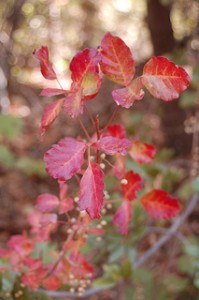 Guest poster Mary Caperton Morton wrote a lovely post about poison oak a few years back, but I just had this itch…
Guest poster Mary Caperton Morton wrote a lovely post about poison oak a few years back, but I just had this itch…
I saw an old friend—or foe, I guess—on a run last weekend. Leafless during winter, the poison oak in a nearby park has started to push out shiny green triads along the trail sides. My bare legs shivered a bit as I ran by.
Poison oak, like its kin poison ivy and poison sumac, is slick with urushiol. The lacquer tree also produces thick, urushiol-rich sap; between June and October, people tap these trees, stir the sap, and evaporate the water to create a lacquer that forms a beautiful protective coating on boxes, bowls, even pens.
But brushed on the surface of susceptible skin, urushiol produces a much less refined veneer of bumpy red rash.
Not everyone is allergic to urushiol. I’ve seen estimates—I’m not sure how reliable—that 50 to 70 percent of American adults can get a reaction from a run-in with an urushiol-oozing plant. For lacquer workers, it can be an occupational hazard; even experienced workers can spontaneously become sensitive to the compound.
People have tried all sorts of ways of curing the rash. In 16th century China, one study reports, China fir soup, purple perilla soup, sealwort soup, and crab soup were considered remedies for lacquer exposure; my husband, who gets a severe case of poison oak exactly where you’d least want it whenever he gets near the stuff, once went into the doctor and, without preamble, dropped his drawers. The doctor’s first response: “Damn!” His second: a cortisone shot.

UC Santa Cruz chemist Rebecca Braslau, who has picked up poison oak from her bushwhacking geologist husband, is also developing a spray that can highlight urushiol lingering on clothes and other surfaces, so that you know how urgently you need to hit the showers and whether to use gloves when picking up your rambling family’s laundry. (My mom got several bad cases this way when I was a kid—sorry, Mom!) Urushiol reportedly bonds to the skin unless you catch it with soap and water in the first fifteen minutes.
The wise head into poison oak territory with long pants and long sleeves—the unwise (at least in our house) rely on a frantic post-exposure scrub with Tecnu. In 1960, a chemical engineer stumbled upon the substance while trying to create a cleanser that could shoo radioactive dust from skin and clothes. Luckily, we haven’t had much experience with nuclear fallout, but since we’ve started using it we’ve only gotten mild cases.
I didn’t get a rash from my recent run, and I was relieved. But then I read an essay this week about taking kids out in the wilderness early. And all right, I felt a little bit intimidated by the author’s extensive expeditions with young children. Mostly, though, it made me realize maybe our poison-oak-free existence has less to do with scrubbing and more with our circumscribed range. My childhood summers came slathered in calamine lotion, but my sons haven’t yet known this soothing pink elixir.
Back then, a rash was a telltale sign that I’d been out doing something fun. Although I don’t welcome one now, I wonder if there’s a bigger itch here that needs scratching.
**
Images
Top: Flickr user Cowgirl Jules Middle: Wikimedia Commons
One thought on “Red Badge of Courage (Or, The One Where I Jinx Myself)”
Comments are closed.